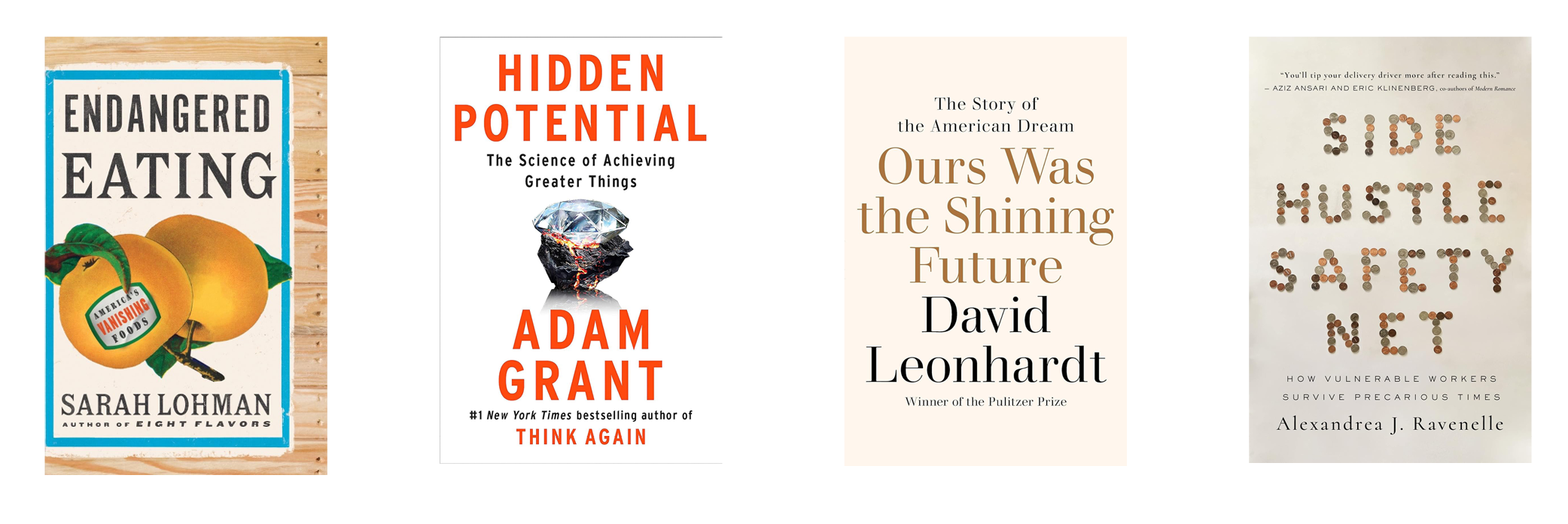October 24, 2023
Finding the right book at the right time can transform your life or your organization. We help you discover your next great read by showcasing four recently released titles each week.
The books are chosen by Porchlight's Managing Director, Sally Haldorson, and the marketing team: Dylan Schleicher, Gabbi Cisneros, and Jasmine Gonzalez. (Book descriptions are provided by the publisher unless otherwise noted.)
This week, our choices are:

Gabbi’s pick: Endangered Eating: America's Vanishing Foods by Sarah Lohman, W.W. Norton & Company
Apples, a common New England crop, have been called the United States' "most endangered food." The iconic Texas Longhorn cattle is categorized at "critical" risk for extinction. Unique date palms, found nowhere else on the planet, grow in California’s Coachella Valley—but the family farms that caretake them are shutting down. Apples, cattle, dates—these are foods that carry significant cultural weight. But they’re disappearing.
In Endangered Eating, culinary historian Sarah Lohman draws inspiration from the Ark of Taste, a list compiled by Slow Food International that catalogues important regional foods. Lohman travels the country learning about the distinct ingredients at risk of being lost. Readers follow Lohman to Hawaii, as she walks alongside farmers to learn the stories behind heirloom sugarcane. In the Navajo Nation, she assists in the traditional butchering of a Navajo Churro ram. Lohman heads to the Upper Midwest, to harvest wild rice; to the Pacific Northwest, to spend a day wild salmon reefnet fishing; to the Gulf Coast, to devour gumbo made thick and green with filé powder; and to the Lowcountry of South Carolina, to taste America’s oldest peanut—long thought to be extinct. Lohman learns from those who love these rare ingredients: shepherds, fishers, and farmers; scientists, historians, and activists. And she tries her hand at raising these crops and preparing these dishes. Each chapter includes two recipes, so readers can be a part of saving these ingredients by purchasing and preparing them.
Animated by stories yet grounded in historical research, Endangered Eating gives readers the tools to support community food organizations and producers that work to preserve local culinary traditions and rare, cherished foods—before it’s too late.
Sally’s pick: Hidden Potential: The Science of Achieving Greater Things by Adam Grant, Viking
We live in a world that’s obsessed with talent. We celebrate gifted students in school, natural athletes in sports, and child prodigies in music. But admiring people who start out with innate advantages leads us to overlook the distance we ourselves can travel. We underestimate the range of skills that we can learn and how good we can become. We can all improve at improving. And when opportunity doesn’t knock, there are ways to build a door.
Hidden Potential offers a new framework for raising aspirations and exceeding expectations. Adam Grant weaves together groundbreaking evidence, surprising insights, and vivid storytelling that takes us from the classroom to the boardroom, the playground to the Olympics, and underground to outer space. He shows that progress depends less on how hard you work than how well you learn. Growth is not about the genius you possess—it’s about the character you develop. Grant explores how to build the character skills and motivational structures to realize our own potential, and how to design systems that create opportunities for those who have been underrated and overlooked.
Many writers have chronicled the habits of superstars who accomplish great things. This book reveals how anyone can rise to achieve greater things. The true measure of your potential is not the height of the peak you’ve reached, but how far you’ve climbed to get there.
Dylan’s pick: Ours Was the Shining Future: The Story of the American Dream by David Leonhardt, Random House
Two decades into the 21st century, we find ourselves in a cynical time. The phrase “American dream” is often used ironically or even with bitterness. Indeed, we hear more about the death of the dream than anyone achieving it. And the stagnation of living standards for most people has been the defining trend of American life. Life expectancy has declined, economic inequality has soared, and the Black-white wage gap is as large as it was when Harry Truman was president.
How did this happen in the world’s most powerful country? Drawing on decades of writing about the economy for the New York Times, Pulitzer Prize-winning writer David Leonhardt examines the past century of American history, from the Great Depression to today’s Great Stagnation, in search of an answer.
To explain both the rise and fall of the American dream, Leonhardt reveals three forces that have shaped our economy: political power through grass-roots movements, the prevailing culture in corporate America, and the government’s investment in making life better for future generations. Tracing the interplay of these three critical forces across the decades, Leonhardt offers an enlightening account of how the United States built the most prosperous mass economy in history after the Depression, and how that economy gradually unraveled.
In engaging, vivid prose, Ours Was the Shining Future offers an essential history that explains our nation’s depleted economic condition, and features the trailblazing figures who helped shape the American dream: Frances Perkins, Paul Hoffman, Cesar Chavez, Betty Friedan, Robert Kennedy, A. Phillip Randolph, Grace Hopper and more. In illustrating the indelible impact these men and women have made—largely through grass-roots democratic movements, from across the political spectrum—Leonhardt also leaves space for hope: If Americans committed themselves to changing our economy again, they would likely succeed.
A sweeping narrative full of human drama, Ours Was the Shining Future is the biography of the American dream.
Jasmine’s pick: Side Hustle Safety Net: How Vulnerable Workers Survive Precarious Times by Alexandrea J. Ravenelle, University of California Press
This is the story of what the most vulnerable wage earners—gig workers, restaurant staff, early-career creatives, and minimum-wage laborers—do when the economy suddenly collapses. In Side Hustle Safety Net, Alexandrea J. Ravenelle builds on interviews with nearly two hundred gig-based and precarious workers, conducted during the height of the pandemic, to uncover the unique challenges they faced in unprecedented times.
This book looks at both the officially unemployed and the “forgotten jobless”—a digital-era demographic that turned to side hustles—and reveals how they fared. CARES Act assistance allowed some to change careers, start businesses, perhaps transform their lives. However, gig workers and those involved in “polyemployment” found themselves at the mercy of outdated unemployment systems, vulnerable to scams, and attempting dubious survival strategies. Ultimately, Side Hustle Safety Net argues that the rise of the gig economy, partnered with underemployment and economic instability, has increased worker precarity with disastrous consequences.
WHAT WE'VE BEEN READING AT HOME
 "I've been reading The Lonesome Bodybuilder by Yukiko Motoya, a collection of short stories. The stories are set in mundane situations yet usually hold a weird, fantastical twist to them. Like the characters in the book, reading this has been a nice way to break up the day-to-day and discover something unexpected."
"I've been reading The Lonesome Bodybuilder by Yukiko Motoya, a collection of short stories. The stories are set in mundane situations yet usually hold a weird, fantastical twist to them. Like the characters in the book, reading this has been a nice way to break up the day-to-day and discover something unexpected."
—Jasmine Gonzalez, Managing Editor



